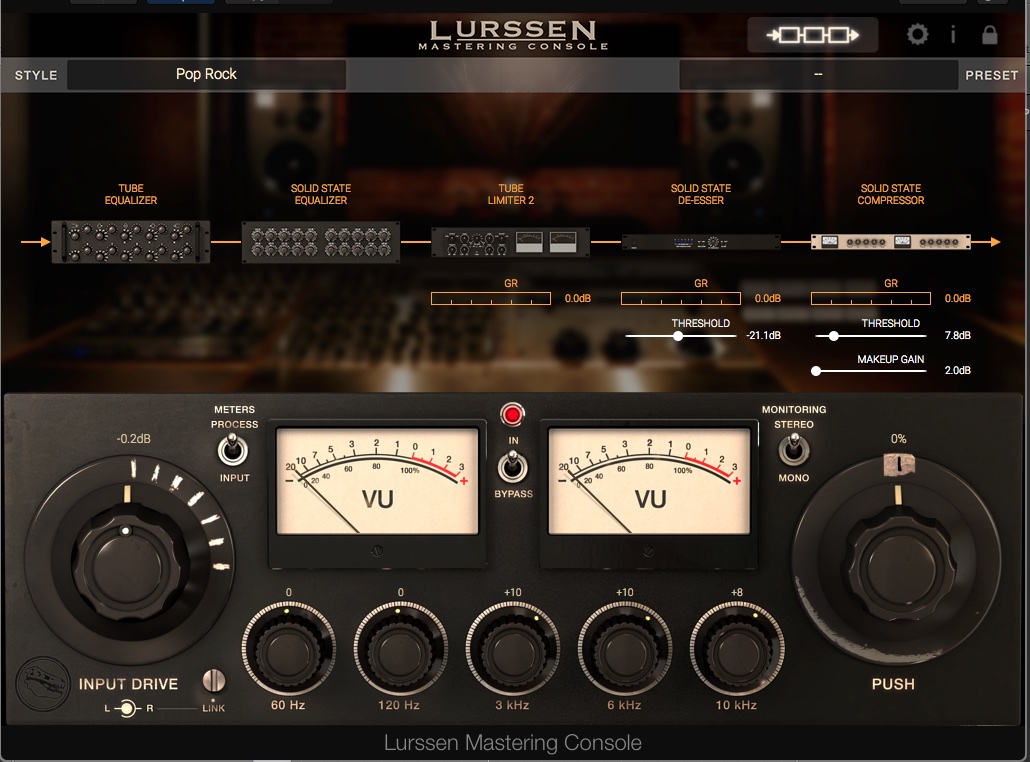New Software Review: Lurssen Mastering Console by IK Multimedia
During last winter’s NAMM show, IK Multimedia promised that they would soon announce a “revolutionary mastering product”. The company released a teaser video giving a clue to one key feature of the new program: The involvement of Gavin Lurssen, whose company, Lurssen Mastering has mastered records for some of music’s greatest stars including Elton John, Queens of the Stone Age, Lynyrd Skynyrd, Snoop Dogg, Bruno Mars, as well as soundtracks for Iron Man, Despicable Me, Up, and other feature films.
Lurssen’s approach involves setting up a pre-configured chain of processors based on the style of material they’re mastering—certain controls on the processors are set to a predetermined value for that specific style and are not adjusted.
IK Multimedia’s Lurssen Mastering Console revolves around that same conceptual workflow: You choose the “Style” template that Lurssen has created for that specific musical genre, and you are essentially able to tweak the same parameters they would be tweaking in their studio. Regardless of the preset, you have access to a 5 band EQ, input drive, and a feature called “Push”. On many presets, you can also adjust the compressor/de-esser threshold and makeup gain.
The most unique knob within this plugin is the Push control, which allows you to increase the amount of boost or cut done by all of the EQ knobs at once, so you can dial up the intensity of your EQ curve with a single automatable parameter. This is based is based on a technique Lurssen uses himself, in order to subtly boost a given section of a song to make it sound more exciting.
In Use
Running the plugin as a standalone app, I couldn’t help but wonder how this plugin would stand up against the now industry-standard iZotope Ozone application.
Comparing presets between the two, I did notice a type of analog “glue” that was apparent by default in the Lurssen Mastering Console, though similar results could be achieved in Ozone via the new analog-style limiter and vintage tape modules.
Though Ozone can be much more flexible and offers significantly more control, Lurssen Mastering Console can make your mixes sound good extremely quickly, which is an important feat in an age where fast turnaround times are the norm.
This aspect of the Lurssen console may be especially useful if you’re a jingle writer working under strict deadlines to get basic mixes of your songs out to a music supervisor—or if you’re a musician looking to add some basic sonic enhancement to your demo mixes and lower-budget self-releases.
While writing music for a television commercial, I used the Lurssen Mastering Console set to the Pop Rock setting. The preset added a lot warmth to the low end in the mix but I did have to take down the 60 Hz and 120 Hz bands which were set at +8 and +10 respectively upon loading the preset.
It seems strange to me that all of the presets in this plugin have the EQ bands boosted anywhere between +8- and +12. Additionally, I found the lack of a threshold control for the Limiter to be quite frustrating and I had to also utilize a 3rd party limiter before sending out the mix. Still, the Solid-State Compressor held its own and sonically reminded of an SSL compressor.
While mastering a rock song with the Lurssen Mastering Console, I noticed it adding some great presence and analog harmonic distortion, which worked particularly well for adding some teeth and impact to drums.
It didn’t take me long to wonder if it would work well as a drum bus processor, and I’m happy to report that I now run a lot of drums (and sometimes bass guitar) through the Lurssen Mastering Console on a separate bus to add some more punch and glue to the rhythm section.
The plugin also has some truly stunning presets for strings, which makes sense when looking through all of Lurssen’s credits on major movie soundtracks. Sometimes, names can be deceiving, as I found the “Pop Rock (More Glue)” and “Pop Rock (Warmer)” setting worked well for a recording of a strong quartet and the “Hip Hop (Brighter)” added some sheen and brilliance as an insert on a Spitfire Audio Albion One orchestral string section in a pop song. The tube limiter in the “Pop Rock” style settings adds some character and warmth to strings that can make them feel far more organic and present in the mix.
Summing it Up
Whether this product is as “revolutionary” as claimed is up to the user. Contrary to its stated purpose, I found that the Lurssen console worked exceptionally well for drum submixes, so I’ve been enjoying it quite a lot on a variety of projects, and for people looking to get into mastering, it’s a great way to take a peek into Gavin Lurssen’s approach, get ideas for refining your own technique, or quickly and inexpensively mastering for clients that need a reference file or an especially quick turnaround.
For a more hands-on look at the Mastering Console, check out this video in which I attempt to master two tracks using the application.
Please note: When you buy products through links on this page, we may earn an affiliate commission.







